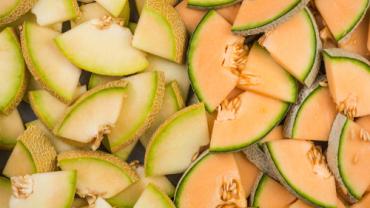
If you’re watching your carbohydrate intake, perhaps you’ve gravitated toward berries when you get a hankering for fruit. Berries are rich in antioxidants and beneficial polyphenols, and they deliver nutrients while having a low glycemic impact. And maybe fearmongering about fructose has scared you away from apples, grapes and bananas. But what about melon? Melons are juicy, delicious, and supremely refreshing on a hot summer day. And the good news is, there’s plenty of room for melon in a healthy diet.
Melons belong to the Cucurbitaceae botanical family, which also includes cucumbers, pumpkin, zucchini and other squashes and gourds. There’s canary melon, Galia melon, Crenshaw melon, and more. Let’s take a closer look at the two you’re most likely to find at the supermarket in North America: cantaloupe and honeydew.
Cantaloupe isn’t that big a nutritional rock star. Compared to beef or leafy greens, it’s not exactly loaded with vitamins and minerals but it definitely fits the bill for a sweet and refreshing treat that won’t wreck blood sugar and insulin levels. A large wedge (about 1/8 of a melon, or 102 g) provides just 9 grams of carbohydrate. There isn’t a whole lot of fiber in cantaloupe, but with only 9 grams of total carbs in a generous serving, this isn’t a high-carb indulgence. Cantaloupe has appreciable amounts of vitamin C and potassium, and it’s high in the same carotene compounds that give carrots and sweet potatoes their bright orange color.
Honeydew has less carotene than cantaloupe, but like its melon cousin, it’s a source of potassium and vitamin C. It’s slightly higher in sugar—about 10 grams net carbs for a large wedge, but still not really enough to scare away those who are carb-conscious. There’s an interesting difference in the composition of the sugars in these two melons, though. Cantaloupe contains about 55% sucrose, 19% glucose and 24% fructose, with smaller amounts of other carbohydrate. Honeydew is a bit lower in sucrose and higher in the monosaccharides: it’s about 30% sucrose, with 33% glucose and 36% fructose. Overall, though, both fruits are relatively low in fructose, and the small amounts of fructose we get from a reasonable amount of fruit in the diet isn’t reason for alarm. Certainly, excess fructose consumption is a problem for many, but with the exception of those who drink large amounts of juice, the fructose onslaught in the modern diet comes mostly from sugar sweetened beverages and sugary foods in general—not from the occasional wedge of fresh melon.
Other than being delicious, do these melons offer any potential benefits for health? Cantaloupe is high in an enzyme called superoxide dismutase (SOD). This enzyme helps protect against damage to our mitochondria and other cellular structures. (The human body synthesizes SOD, but we get additional amounts from our food.) Supplementation with melon-derived SOD has been shown to improve insulin sensitivity and vascular function (blood vessel health) in animals, and to reduce physical and mental fatigue in humans. SOD can be difficult to deliver intact to the body, though. (Because it’s an enzyme, that means it’s made of protein, so it has to be formulated in such a way that stomach acid doesn’t denature/destroy its effectiveness.) So to get some SOD from melon, it’s probably best to just eat melon!
There are plenty of ways to incorporate cantaloupe and honeydew into your diet. They’re both delicious consumed all by themselves, or you can make your guests feel special by wrapping cantaloupe wedges in thin slices of salty, fatty prosciutto. Add some figs and goat cheese for a stunning and satisfying salad that checks all the boxes: sweet, salty, acidic, fatty. Speaking of fat, since the carotenes in cantaloupe are better absorbed when consumed along with a bit of fat, a good strategy is to pair cantaloupe with avocado and an olive oil-based dressing. Melon salsa with cantaloupe, honeydew and watermelon is as pretty as it is refreshing—a sure winner for warm weather cookouts. For something more on the savory side, this unique cantaloupe gazpacho with shallots, garlic and basil is certainly outside the ordinary, or try curried pork chops with a cooling side of honeydew and cucumber. For those who prefer to sip their cantaloupe, this shake with cantaloupe, lime and toasted coconut will hit the spot, or a cucumber melon white sangria could be the hit of your next party. Another great treat for an adults-only summer cookout is margarita melon salad—cantaloupe, honeydew, watermelon, and tequila!
Sources